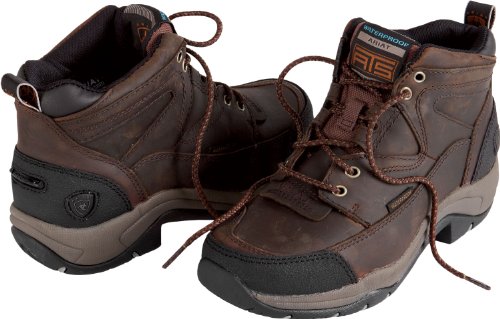Shoes See ARIAT WOMEN'S ALL TERRAIN WATERPROOF BOOTS COPPER (7) Details
Product Description
Wet conditions are no problem for the Ariat® terrain H2O. It sports waterproof leather on the outside and an internal waterproof membrane. Water isn't getting in - and a moisture-wicking lining keeps sweat at bay, too. Your dry feet will also appreciate built-in stabilizing, cushioning ATSTM (Advanced Torque Stability) technology. Ariat® spur rest. Removable kiltie.
- Built tough, so you can get OUT there!
- WATERPROOF, oiled full grain leather upper
- Moisture-wicking lining keeps feet dry, from the inside out
- Stabilizing ATSTM composite fiber forked shank
- Tough DuratreadTM outsole with slip-resistant tread
More About ARIAT WOMEN'S ALL TERRAIN WATERPROOF BOOTS COPPER (7)
The American USMC KA-BAR Fighting/Utility Knife became one of probably the most successful knives in use. Created by the Union Cutlery enterprise in 1941 this all-purpose survival tool was exclusively government order and built to be effective as a defensive weapon, hammer, can opener, digging tool, and cutting tool.The origin of those very first prototype of these KA-BAR, the 1219C2, had its roots in World War I.
World War I
The stalemate entrenchment of World War I officially brought the fighting knife back to the battlefield. The trench systems in Belgium and France extended for countless miles and close-quarter fighting between the Allied and German troops continued within the environment of the trench. Soldiers were required to cut-down their 19th century long-sword bayonets that most nations still issued. These cut-down weapons enabled close-quarter hand-to-hand combat.
It became apparent through the end of World War I that a new knife design was needed to meet the demands of not just close-quarter fighting but versatility of use. After detailed comparison of the trench weapons then in Make usage of the United States and France began production of these Mark I Trench Knife, in 1918, during the last months of those war. Many of these weapons were never issued.
The Mark I was a cast-bronze knuckleduster. The pommel was secured to its cast-bronze hilt having a nut that had a severe point And also this if employed with other enough force can frequently fracture a mans skull. The weapon could be carried whilst crawling and kept securely at the hand. using a 7 double-edge blade, it was helpful for thrusting and cutting. Yet, because of expense and soldier complaints of blade breakage, the Mark I had a short production life in support of 120,000 were made.
With the wars end in 1918 the evolution and development of those military fighting knife continued.
World War II
When the United States entered World War II in 1941 most Americans were armed Using the pre-World War II 16 M1905 Pattern Bayonet (later renamed M1942); as well as the U.S. Army had only one fighting knife the Mark I.
The Marine Corps issued the Marine Raider Stiletto to its elite forces but the stiletto was most helpful for silent killings Rather than general utility tasks. many Marines obtained their incredibly own knives before deploying. These were for one of the most part the hunting/utility knife L76 and L77 by Western States Cutlery.
The proposed reproduction of these Mark I was rejected and the U.S. Government requested military knife suppliers to produce specifications to get a modern fighting knife employing the designs of those Mark I as well as the civilian hunting/utility knife patterns.
several changes to previous pattern designs resulted at the 1219C2 prototype. Made with other thicker blade stock, added fuller, straight cross-guard and peened pommel; it also had the now famous compressed leather washers in the handle. The 1219C2 was later coated using a non-reflective matte phosphate finish to reduce glare. (Marines to this day nonetheless add an extra coat of black paint for glare reduction and corrosion resistance).
On November 23, 1942 the United States Marine Corps adopted the 1219C2 Which it later re-designated the USMC Mark 2 Combat Knife. The United States Navy at the same time adopted the 1219C2 as the US Navy Utility Knife, Mark 2.
The Mark 2 became general issue to the United States Marine Corps, and returning veterans were impressed by its combat effectiveness.
The Union Cutlery business stamped their Mark 2 Combat/Fighting Utility knives With all the "KA-BAR" trademark, and as early as 1944 Whatever the case of manufacturer all Mark 2s became known as the KA-BAR.
used in eight wars World War II, the Korean War, Vietnam, Grenada, Operation Just Cause, Gulf War, Afghanistan, and Iraq the KA-BAR has hit the mark as one of the most successful knives made.
Todays KA-BAR is made of 1095 Cro-Van Steel, flat ground, effortless to sharpen, and features a 20 degree edge angle and it is effective as a combat knife and utility tool. using a hardness rating of 56-58 HRC, the moderate carbon and low chromium steel combination enables the blade to hold its edge very well.
as well as the legend born during World War II continues, and over seventy years later the dual-purpose design is still doing its job.
ARIAT WOMEN'S ALL TERRAIN WATERPROOF BOOTS COPPER (7) Reviews
ARIAT WOMEN'S ALL TERRAIN WATERPROOF BOOTS COPPER (7):Shoes



No comments:
Post a Comment